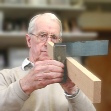

The circular sawbench has developed into a versatile machine capable of doing much more than ripping. Modern carbide tipped saws enable precise cuts with quite a good finish.
Individual workers who lack the range of facilities of larger workshops may wish to use the saw for sawing tenons, rebating, grooving, deep cutting, cutting housings (dados), comb joints and so on. Safety in these operations will sometimes require the removal of the riving knife (and possibly the crown guard). Unless the workpiece is adequately supported and effective alternative guarding is provided, these operations are unsafe. Some of this work will be on quite small workpieces where the risks of injury are increased.
Virtually all this circular sawbench advice has been culled from authorative sources whose advice will have been gained from longstanding and widespread experience.
These notes are intended for amateurs working by themselves. It is up to them first to evaluate and if thought to be appropriate, then prudently apply the advice in a manner appropriate to their own circumstances.
In principle, aim always to conduct a smooth and uneventful operation. When sawing the operator always knows that there is a risk of injury so anything that disconcerts him/her can influence judgement (maybe even cause some panic) and possibly induce a reaction that makes the situation worse. For example, check that the table is smooth and free from contaminants that might hinder the smooth progress of the work as it is fed to the saw. Grooved tables sometimes found on lightweight saws can sometimes cause difficulties.
If you are worried about an intended operation mentally rehearse it. Better still, lower the blade below the table and make some trial passes, especially if feather boards have been fitted.
Avoid using the machine while upset or under the influence of alcohol or drugs. In the former case, have a good tidy-up or do some heavy mortising instead.
Consider situations in which alertness and attention might be distracted, (though it might be difficult to anticipate the situation in which somebody damaged his hand after being stung in the buttocks by a bee).
Avoid overfamilarity, for example sweeping away sawdust near the saw teeth with the hand or reaching between the fence and the blade. Use the pushstick instead of the hand.
Do not fit devices not intended to be used on the machine. Abrasive disks are an example. The speeds are wrong and the arbor flanges are inappropriate.
Be sensitive to sounds and smells that tell you that something is going wrong.
Avoid loose clothing that might get caught.
Other than a proper controlling device, don't hold anything else (eg calipers, rule) in your hands while operating the machine.
Wear good quality ear protection.
When maintaining the machine, ensure that it is completely isolated from the power supply.
When switching on, some workers need to bend to reach the front panel of a cabinet saw. This can lead to the habit of supporting the body with the other hand resting on the saw table. In view of the accidents reported while switching off, it would be a good idea to avoid getting into this habit.
Some workers are able to modify the switch of their cabinet saws to enable the stop button to be operated with a knee. Though this can undoubtedly be convenient, please see below.
After switching off, the saw can still take a long time to run down and do a lot of damage. The accident reports indicate the kind of injury that can happen immediately after switching off. One tip is not to bring hands near the saw until the teeth can be counted.
Attention might be distracted when thin offcuts get caught between the blade and the insert and dragged downwards by the front teeth. Though the risk should be pretty obvious, there can be a temptation to pull it out. Make a wooden 'Zero Clearance' insert.
Before sawing, check the material for loose knots, splits starting at the ends of boards, included grit, nails and suchlike. When a kerf reaches a split, wedges can be formed that can then be ejected at the sawyer.
Make sure that the floor is free from oil, offcuts and other obstructions.
Ensure that small sawbenches (eg table saws) are firmly fixed on a support that will not overbalance.
Working small sizes can be very risky. In the case of extremely small stuff such as for wooden jewellery, glue the material to a suitable supporting strip, making sure its the lower surface is adequately supported by the saw table and there is a safe length for the sawyer to hold.
Keep bystanders well away from the sawbench. Don't let them walk anywhere near the board as it emerges from the table, nor at the rear of the saw. You could try asking them to sit at some safe place.
Don't allow friendly but inexperienced helpers to act as 'takers off'. They can pull the material through the saw faster than you expect. Also they can mis-steer the work and cause a kickback.
The workpiece should always be guided by the fixed or moving fence (mitre guide).
Any twist or sideways movement while cutting freehand can easily lead to a kickback, especially if this happens before the kerf acquires the guidance offered by the riving knife.
Avoid accumulating offcuts on the table top. Vibration can sometimes lead to them drifting onto the blade. If a pile tumbles, it can be distracting (to say the least).
And finally, when working alone, it could be very important to have some means of calling for immediate help.